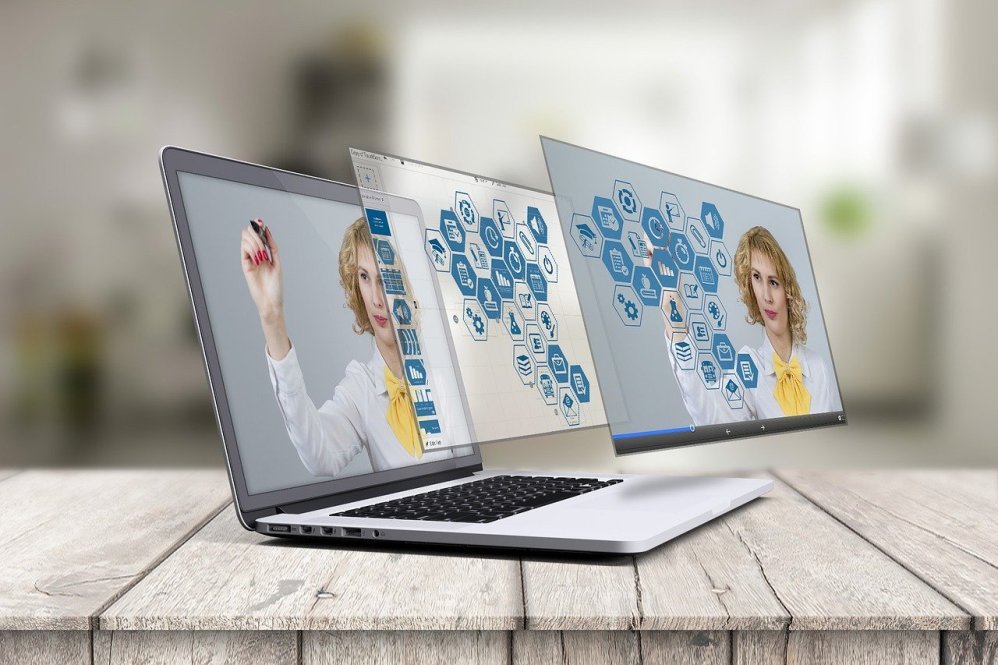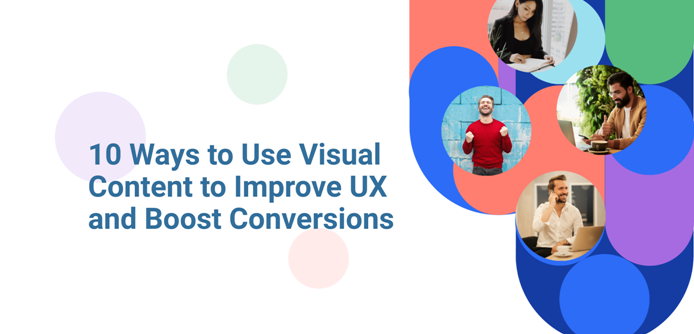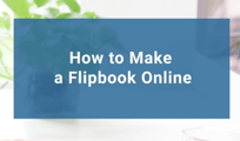Humans are visual creatures, and in the age of Pinterest and Instagram, it’s well understood that visuals are of massive importance in the online world. An appealing website can enhance the online experience and be the ticket to increasing your conversion rates. And the right visual elements can turn visitors into customers and also boost brand value.
What looks good to the eye, also sells easily. A well-designed website that appeals to the customer is especially important in eCommerce. The customer experience has changed in many ways with the advent of online shopping and marketing. So you need spectacular content to stand out from the competition and lure customers in to discover and buy your products and services. Your customer’s user experience on your website is dependent on the visual elements you use.
In addition to a better customer experience, visual content is effective in attracting customers and boosting your conversions. A good mix of graphics, videos, motion banners, infographics, and images can improve the user experience in the following ways:
- It can build trust among customers. All the cues on your website are visual, so your first impressions are, too. Your visual content needs to be authentic and eye-catching to make an excellent first impression.
- It helps boost the visibility of popular products.
- Makes complex information easier to understand in the form of infographics.
- Visuals offer social proof. Pictures of customers using your products or a video of a customer testimonial or customer review can be great forms of social proof. Your customers would rather trust other consumers than the brand.

Source: Pixabay
If you are looking to build a new website, choose website builders like Wix or Squarespace. These can help you construct sites with optimized visual content. If you want to offer a delightful user experience to guide prospective customers down the conversion funnel, here are a few ways to use visual content to do just that:
#1 3D Videos
Videos are the best kind of visual content to feature on your site. The use of videos adds audio cues, and when both visual and auditory senses are engaged, you can expect customers to stay on your website for longer. Plus, you will see your bounce rate decrease.
If you do indeed want to leverage video for your website, use a 3D video. It can give prospective customers a unique insight into your product. The angles and magnification just aren’t possible with static image photography. 3D video also removes imperfections from images and makes them more attractive. Thus, 3D video can encourage users and influence their order fulfillment process. In a survey, 86% of people said that video influenced their purchasing decision.
#2 Infographics
While blogs and long-form written content are great for search engine optimization, when information and statistics are displayed through an image, it can generate large amounts of traffic. An infographic visualizes statistics and data in an attractive and engaging way.
Infographics are popular because they’re designed to catch your eye, the information in them is concise and to the point. They can help explain complicated products in simple ways, highlighting features, and can act as informational and marketing tools, presenting data.

Source: Pixabay
#3 Personalization
Personalization is at the forefront of digital marketing efforts. Customizing your visual content to appeal to prospective customers can do wonders for your conversions. The image presented to your audience can be personalized in real-time thanks to hyperautomation and machine learning, allowing people to relate more to your content.
If you know that you have a 20-year-old woman browsing your apparel website, changing your website's images to show similarly aged women wearing the apparel should enhance engagement.
#4 White Space
White space is essential; it helps the eye and the brain rest. White space doesn’t have to be actually white—your content just needs to include an empty space that allows the visual design to open up.
If you don’t have enough white space, your key visual elements will not stand out. So adding white space allows images to be retained in the short-term memory, which is critical if you want to keep a customer engaged long enough to convert them.
The following points are essential when designing for white space:
- Key visual content should have white space all around it.
- Avoid thick borders.
- Control placement and visibility of navigation menus so that they don’t distort the white space.
- Open up the text by reducing line length and avoiding the use of bold and italics. Put text in a specifically sized text box.
- White space gives your customer some relaxation time and an opportunity to refocus. The right amount of images with an added open space can make for a calm and engaging web experience.
#5 Accessibility
Just as physical stores have been developed to be accessible so that all people, regardless of disability, could visit, ecommerce stores need to be accessible too. An accessible website will increase customer retention, as improved accessibility means an improved user experience. If you need to create a website, consider using white label web development services instead of doing it by yourself.
Plan your design to accommodate the visually impaired or those who suffer from manual dexterity problems. Other disabilities that need consideration, because they can affect how a user engages with your content, include dyslexia, ADHD, and color blindness.
These tips can help you move in the right direction to make content accessible to all:
- Use high-contrast color combinations. For example, avoid yellow on a white background. High contrasts help your main visual elements stand out.
- Update Alt Text, so images are tagged for visually impaired readers.
- Use the font that’s most easily readable and is in an appropriate size—at least at 12pt—for anyone with even the slightest visual impairment.
- Avoid lightweight fonts.
- Use bullet points.
- Add subtitles to videos.

Source: Pixabay
#6 ‘Shoppable’ Images and Videos
We have concluded that videos and images can significantly impact your conversions and gross profit margin. However, if a customer sees a video of your product and then goes to your website and fails to locate it, that’s a failed user experience. If you want to compel your prospective customers to buy a product, images should link directly to the product page, with the specific stock keeping unit or SKU, where they can click ‘Add to cart’.
Images shared on social media platforms should have links embedded that allow users to buy the product by clicking on the image. You are losing out on multiple opportunities if you expect users to see a product on one marketing platform and locate it themselves to buy on another.
Make your digital marketing videos and images shoppable to avoid having customers abandon their interest altogether. In this era of omnichannel marketing, it’s crucial to connect your websites seamlessly to other social media platforms and make every picture of a product on your webpage shippable.
#7 User-Generated Content
User-generated content significantly impacts a customer's purchasing decisions. If you want to increase brand value and build trust among your customers, use customer-created content on your website. Nothing can convince a prospective customer to buy something more effectively than seeing someone else using the product. This is called social proof.
When you include photos or videos of real customers, you convince your audience that your product is popular with real people. This marketing strategy can be rewarding, as it enhances the new customer experience, provides a digital customer journey, and allows existing customers to play a role in your company’s success.
Testimonials that include images have long proved to attract customers to step down the conversion funnel. What’s more, these visual aids don’t have to be professional; in fact, that’s what makes them authentic and relatable.
#8 Exceptional Photography
How do you make the average product more enticing to someone browsing through your website? You take the most exceptional photograph of it and put that front and center. A clear, attractive image can go a long way in making your products come alive.
Professional photographs add a polished edge to product images. A well-taken picture that is also edited professionally stands out and grabs attention. Our brain processes images faster than text so take advantage of this and ensure your images are of the highest quality.
Avoid cheesy stock photos and use original content: Try using images of your products in action. Relevant images stir emotion and ultimately increases your audience engagement.

Source: Pixabay
#9 Unboxing Videos
Creating knockout unboxing videos has become a raging trend among influencers. Customers create videos of themselves opening a product for the first time. This is a goldmine for your eCommerce website. If you’re going to have any video content on your website, let it be unboxing videos. The point is not to go viral but to pique consumer interest.
Unboxing videos are a great way to engage customers. If you have the budget for it, you could ask a famous influencer to do a sponsored unboxing video, which can bring new traffic to your website from their Instagram or YouTube.
#10 Augmented Reality
Online shopping is convenient. It can’t, however, compare to the brick-and-mortar store experience. With just two of your senses engaged (sight and hearing), there is only so much that an eCommerce store can do to feel like a physical store. But with the advent of augmented and virtual reality, this has changed.
Augmented reality (AR) can help users visualize your product almost as if they had it in hand. This real-world feel is a considerable advantage for selling things online. For instance, if you're selling glasses, you could add a virtual try-on option so your customers can see how the glasses will look on their face before purchasing.
If you sell something that has features that are hard to explain satisfactorily in words, or would like to make a dynamic sales presentation on your website, AR could help you considerably.
AR creates a 3D interactive experience and is great to provide a real look at product lines, too. Another use of AR is to create 3D models of data sets, since the average person finds it hard to visualize data.
Make sure to carry out agile testing on your AR software before you feature it on your website and take customer feedback to keep improving it. AR is developing as we speak, but its potential is massive.

Source: Pixabay
Visual Content has Massive Potential
Running a successful website is not easy. From retail inventory management to search engine optimization and creating an extraordinary customer experience, the many facets of the online world can be exhausting to manage. The whole point is to drive conversions, and a website with a poor UX will do the opposite. That's why many companies order different UI/UX design services to optimize their e-commerce stores, personal websites, and platforms.
If you want to improve your website's user experience, the 10 ways listed above can help enhance your visual content and deliver real value to your customers. Captivating visual content can engage customers at multiple points in the customer journey, which will lead to more conversions and increased customer loyalty.
The opportunities that spectacular visual content offers are limitless. It’s up to you to make the most of it and offer your customers the best online experience.
Author's bio:
Xiao is the Global Head of Lead Generation at Brightpearl, a leading retail operations platform. She is passionate about setting up innovative strategies to grow sales pipelines using data-driven decisions.





